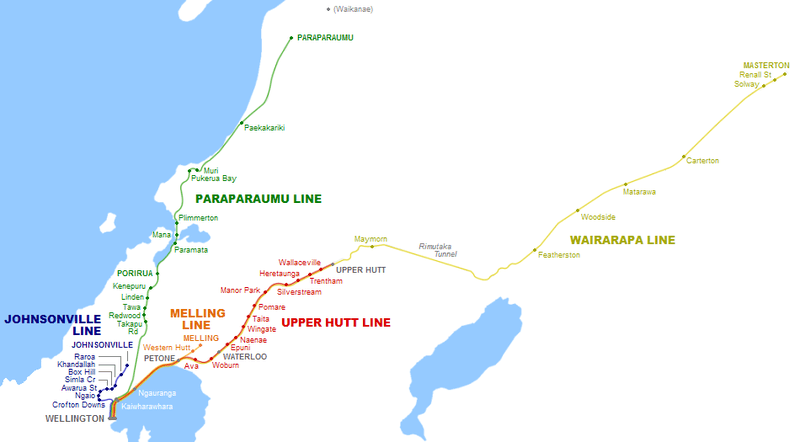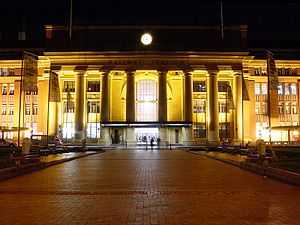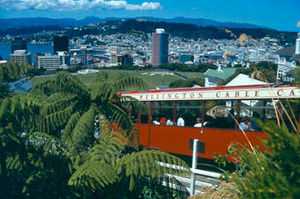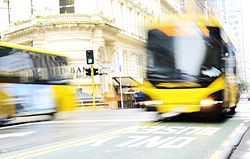Public transport in the Wellington Region
 | |
|---|---|
|
Buses in front of the Old Bank Arcade | |
| Locale | New Zealand |
| Service area | Wellington |
| Service type | Public transport in Wellington |
| Fuel type | Diesel, electricity |
| Operator | GO Wellington, Valley Flyer, Tranz Metro, Mana Coach Services, Newlands Coach Services |
| Website | metlink.org.nz |
Public transport in the Wellington Region is well developed compared to other parts of New Zealand. It consists of buses, trolleybuses, trains, cars, ferries and a funicular (the Wellington Cable Car). It also included trams until 1964.
Buses and ferries are privately owned, with the infrastructure owned by public bodies, and public transport is often subsidised. The Greater Wellington Regional Council is responsible for planning and subsidising public transport, and pays around NZ$30 million for bus and train services each year.[1] The services are marketed under the name Metlink. The system covers Wellington city, Lower Hutt, Upper Hutt, Porirua, the Kapiti Coast and the Wairarapa.
System
Usage
According to the Regional Council,[2] around 35 million passenger trips are made by public transport in Wellington each year, and this number has been growing in recent years. The Wellington region has the highest per capita use of public transport in New Zealand,[3] with 72.85 trips per capita in 2013/14.
Of the approximately 35.80 million trips, around 23.98 million are made by bus, 11.64 million by train, and 0.18 million by ferry.
| Year | Bus | Ferry | Rail | Total patronage[4] |
|---|---|---|---|---|
| 2001/02 | 19,795,687 | 114,163 | 10,163,061 | 30,072,911 |
| 2002/03 | 20,711,898 | 117,027 | 10,010,448 | 30,839,373 |
| 2003/04 | 21,338,606 | 127,110 | 9,953,408 | 31,419,124 |
| 2004/05 | 21,902,604 | 137,844 | 10,253,811 | 32,294,259 |
| 2005/06 | 23,487,552 | 155,799 | 11,097,423 | 34,740,774 |
| 2006/07 | 22,794,990 | 156,718 | 11,175,993 | 34,127,701 |
| 2007/08 | 22,964,384 | 177,128 | 11,552,453 | 34,693,965 |
| 2008/09 | 23,381,247 | 179,981 | 11,875,820 | 35,437,048 |
| 2009/10 | 23,647,840 | 182,034 | 11,133,677 | 34,963,551 |
| 2010/11 | 24,026,904 | 176,581 | 11,202,227 | 35,405,712 |
| 2011/12 | 24,111,291 | 176,698 | 11,274,141 | 35,562,130 |
| 2012/13 | 23,607,936 | 192,549 | 11,355,403 | 35,155,888 |
| 2013/14 | 23,981,194 | 180,155 | 11,643,292 | 35,804,641 |
Extent
The Regional Council's Regional Public Transport Plan[5] notes Wellington had:
- a rail network with 147 carriages, serving 53 stations
- a bus network with 470 buses (including trolleybuses) serving around 2,800 stops on around 108 routes
- two harbour ferries
- a five-station funicular, the Cable Car.
GIS information indicates that 77% of the region’s population lives within 800 metres of public transport stop with a 30-minute frequency or better.[6]
Wellington's hilly terrain has a considerable effect on public transport. Some planners consider Wellington to be a "good" city for public transport management, as the topography concentrates settlement in valleys or along coastlines, providing clear, dense "corridors" for transport routes. At the same time, however, the hilly terrain proved a hindrance for the construction of rail and tram lines, and buses sometimes have difficulty on narrow and winding streets.
Modes
Buses

Wellington has an extensive network of bus routes. Routes are determined by the Regional Council, which regulates commercially provided services and solicits bids from private operators to run the services it is prepared to subsidise. The largest operator is NZ Bus, which provides services for most of Wellington city under the GOWellington brand and for the Hutt Valley under the Valley Flyer and Runciman Motors brands. In Porirua and the Kapiti Coast most services are provided by Mana Coach Services, which also owns Newlands Coach Services, serving the northern suburbs of Wellington - Newlands, Johnsonville, Churton Park, Paparangi and Grenada North.
The majority of buses in the Wellington area are powered by diesel, but GOWellington has 60 trolleybuses that it operates within Wellington city. The trolleybus network was introduced between 1949 and 1964 to replace Wellington's trams (see below).
All GOWellington and Valley Flyer buses accept the contactless Snapper card. As of April 2011, GOWellington buses report real time location information which is displayed on electronic signs in some Wellington bus stops and can be viewed online.[7]
Trains

Wellington and Auckland are the only two cities in New Zealand to have suburban passenger trains. Wellington's rail network is used primarily by commuters travelling to and from the central city — all lines converge on Wellington Railway Station.
There are two major rail corridors in Wellington. The North Island Main Trunk runs along the western coastline, passing through Porirua and Paraparaumu to Waikanae on the Kapiti Coast; the Wairarapa Line runs along the edge of Wellington Harbour and then up the Hutt Valley, passing through both Lower and Upper Hutt. Less frequent services continue through the rural Wairarapa, stopping at a number of small towns before terminating at Masterton. There are also the Johnsonville Line in the north of Wellington and the Melling Line on the western side of Lower Hutt. Lines are double track except for a short stretch between Muri and Paekakariki on the NIMT and then north of Waikanae, the Wairarapa Line beyond Trentham, and the Johnsonville and Melling Lines, which are single track.
There are long-distance trains to Palmerston North (the Capital Connection commuter train) and Auckland (The Northern Explorer). These are not part of the Wellington transport system.

There are 49 stations in the rail network, all except Wellington Railway Station owned by Greater Wellington Regional Council. Wellington Station is the busiest by far, with trains arriving and departing every few minutes at peak times. The next busiest stations are Porirua, Waterloo (in Lower Hutt) and Johnsonville. Most stations are served by only one line.
Passenger trains are owned by Greater Wellington Regional Council. They are operated by Tranz Metro, and the rail infrastructure is owned by KiwiRail, its parent. The Regional Council estimates that around 800,000 train trips are made each month.
Most trains are electric multiple units (EMUs) in sets of two to eight cars. The majority of cars are FP class Matangi units, introduced from 2011. The remainder are EM class Ganz Mavag units, introduced in the 1982 and extensively refurbished in the late 1990s. They displaced the older DM class English Electric units, the last of which were withdrawn from service in 2012. The Wairarapa line beyond Upper Hutt is not electrified, so Masterton services use diesel-hauled SW and SE class carriages.
Ferries

Only the western and northern shores of Wellington Harbour are heavily populated, and the trip between these population centres is often as quick along the coast as it is by water: demand for ferries has been lower than might otherwise be expected. Two ferry routes are operated by East by West, a private company: daily between central Wellington and Days Bay on the eastern coast, near Eastbourne, serving Seatoun at peak times from 3 April 2008; and the Harbour Explorer Excursion at weekends, also serving Petone and Seatoun. Off-peak and weekend sailings call at Matiu / Somes Island, a nature reserve.
Historically ferries also served Miramar, Karaka Bay, and Eastbourne proper. These routes were discontinued as road connections around the region improved.
There are also larger road and rail ferries that cross Cook Strait to the South Island. These are not part of Wellington's public transport system.
Cable Car

The Wellington Cable Car, which runs between the central city and the hill suburb of Kelburn, is something of a Wellington icon. It is used by commuters travelling to and from work, by people travelling from the city to the Wellington Botanic Garden, and by students at Victoria University.
Despite its name it is a funicular with two counterbalanced cars permanently attached to each other by a cable, rather than a true cable car, where the cars grip or release the cable as needed. The cable runs through a pulley at the top of the hill, driven by an electric motor. Originally the Cable Car was a hybrid between a true cable car and a funicular, and retained its name when it was converted to a full funicular.
It is owned and operated by Wellington Cable Car Ltd, a wholly owned subsidiary of Wellington City Council. Until 2007 it was operated under contract by Transfield Services, a private company. Unlike most other public transport in Wellington, it runs without subsidy.
Trams (historic)
Between 1878 and 1964 Wellington had trams[8] serving the western, eastern and southern suburbs, with the northern suburbs served by trains. The trams were replaced by buses or trolleybuses, and occasional calls are made for light rail to be reintroduced.
Following the 2010 mayoral elections, Mayor Celia Wade-Brown pledged to investigate light rail between Wellington station and the airport.[9][10]
References
- ↑ What Greater Wellington and the Government are doing
- ↑ Metlink website - Statistics
- ↑ Greater Wellington Regional Council 10-Year Plan 2009-19 - Key Issues
- ↑ Metlink website - Statistics
- ↑ Greater Wellington Regional Council - Regional Passenger Transport Plan 2007 - 2016 Adopted August 2007
- ↑ Wellington Regional Land Transport Strategy target assessment March 2010
- ↑ Greater Wellington Regional Council - Real time information arrives
- ↑ A Wheel on Each Corner, The History of the IPENZ Transportation Group 1956-2006 - Douglass, Malcolm; IPENZ Transportation Group, 2006, Page 12
- ↑ Nichols, Lane (18 October 2010). "Just how green will we go under Celia?". The Dominion Post. Retrieved 4 November 2011.
- ↑ "New mayor's dream ride". The Dominion Post. 1 November 2010. Retrieved 4 November 2011.
External links
| Wikimedia Commons has media related to Public transport in Wellington. |
| ||||||||||||||||||||||
| ||||||||||||||||||||||||||||||
